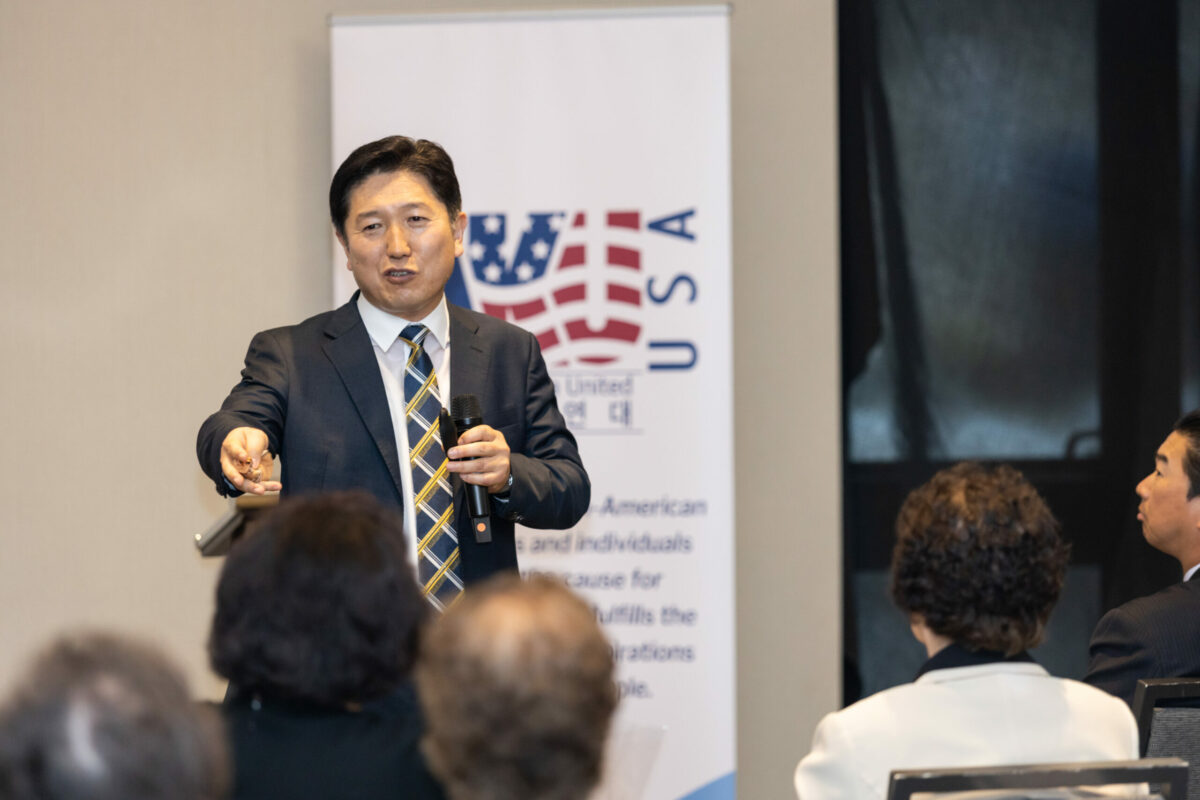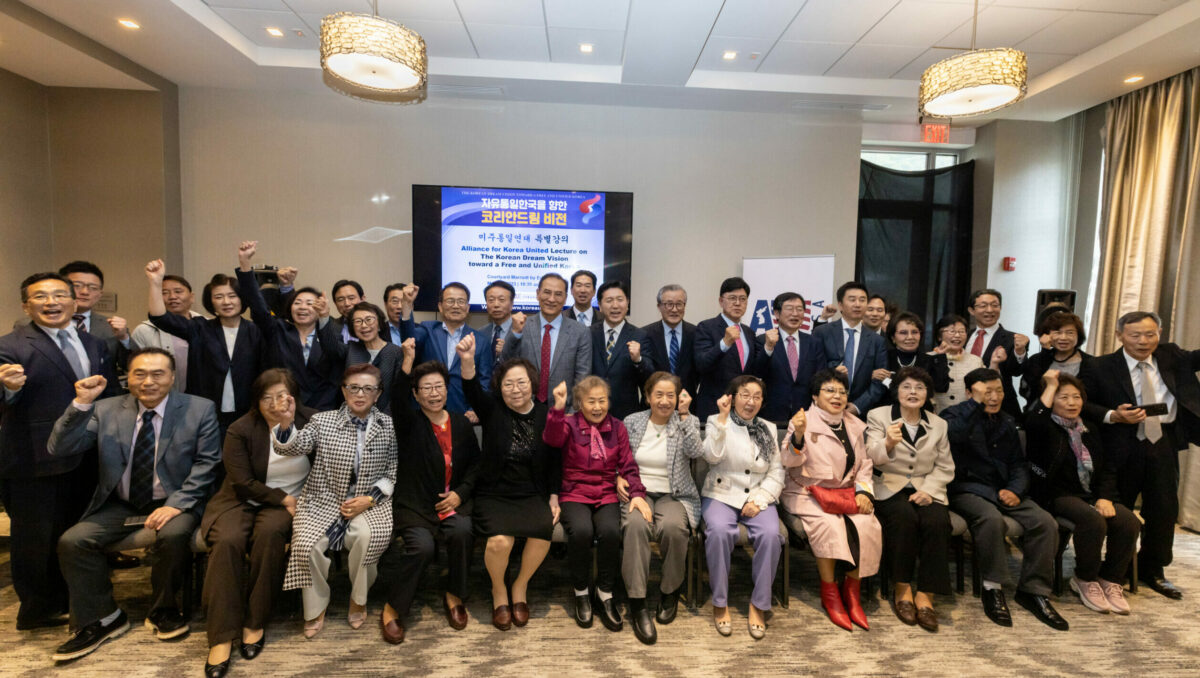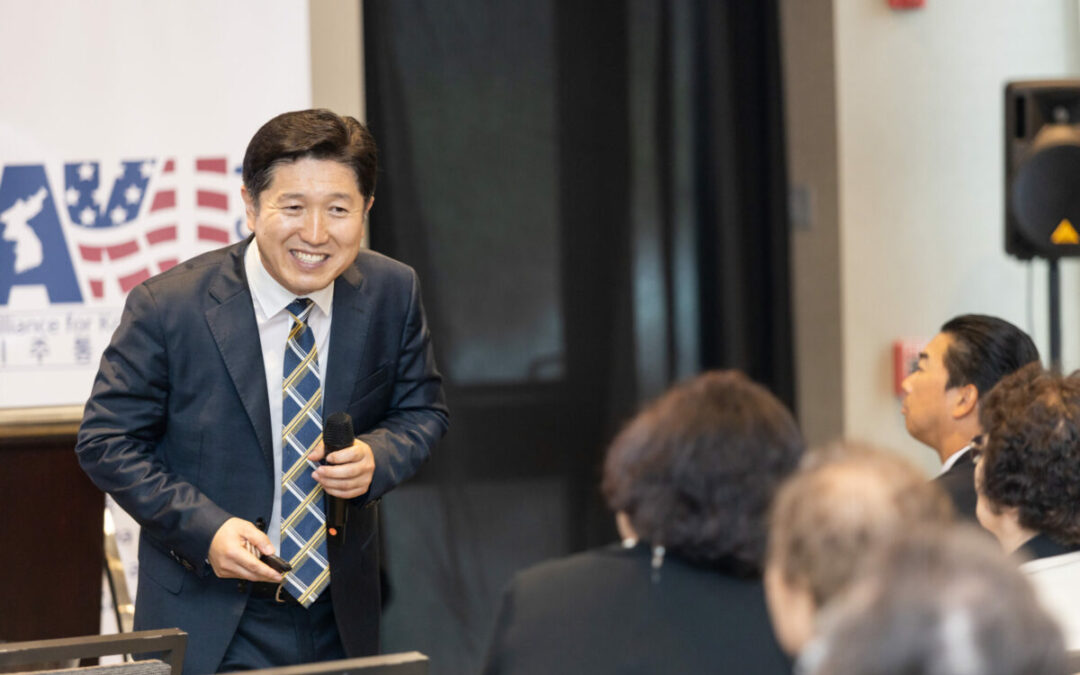Dr. Hyun Jin P. Moon’s innovative approach to Korean reunification is expressed through the Korean Dream, a vision that draws upon the ancient Korean philosophical ideal of Hongik Ingan. This vision is that a reunited Korea will become a model nation that can “benefit all mankind.” It challenges the divided peninsula to discard the foreign construct of division and recognize its common identity and destiny.
In an event organized by Alliance for Korea United USA, Mr. Inteck Seo (co-chair of Action for Korea United) gave a passionate lecture in New York City on May 20, 2023, encouraging fellow Korean Americans to become owners of the Korean Dream. “Reunification will not happen on the level of government, as it has been tried and failed over and over again. It must be the Korean people and civil society that lead the efforts for reunification.”
May 20, 2023
This year marks the 120th anniversary of the immigration of the first Koreans to America. Arriving in 1903 to work on the sugar plantations in Hawaii, they made their mark in the country and paved the way for future generations of Korean Americans. This year also marks the 70th anniversary of the U.S.-ROK Alliance, signifying the deep bonds of friendship between the Korean and American people. Last month, Alliance for Korea United USA held a special lecture event in New York featuring Mr. In-teck Seo, co-chair of Action for Korea United, a grassroots coalition of more than 1,000 South Korean NGOs and civic organizations advancing the cause of peaceful reunification. Members of the local New York and New Jersey Korean American communities gathered to learn more about the significance of reunification and the role they can play in these efforts.
Changing Realities of North Korea
Many South Koreans have a negative attitude toward reunification due to perceptions of their neighbor in the north. How could we unify our country when the Kim regime is continuing to starve its own people and develop more advanced nuclear weapons? However, we are living in a time where the opportunity for reunification is ripe due to changing circumstances within North Korea, Seo said.

He explained that North Korea has utilized two main methods of controlling its people: a centrally planned economy and media censorship. However, the people’s trust in government has declined since the famine of the 1990s. The people had to make a living on their own, which resulted in Jangmadang, or North Korean black markets. In addition, North Koreans are getting their hands on USB drive that contain foreign media, including South Korean dramas. “The North Korean government’s control over its people is slowly declining, and the people’s trust and dependency on the regime is declining,” Seo said.
Rise of Statist Powers in the Region
It is also important to understand what is happening in the surrounding countries in Northeast Asia, which is arguably the most consequential region in the world right now. The U.S. and China are now battling for global hegemony in what Seo called “a values-based conflict.” Seo explained that although China incorporated a capitalist economic system, they have held onto their communist ideals. “There is no freedom of religion in China. This is so significant because the freedom to believe, or the freedom of conscience, serves as the basis for all other freedoms, including freedom of speech, press, assembly, etc.” We can see by China’s recent actions, including the Hong Kong National Security Law, the repression of the Uyghur population, and the threat to take over Taiwan, that China is actively seeking to overtake America as the world’s superpower.
Another major conflict is the Russian-Ukraine war. Seo explained that although Putin predicted the war would be over in one week, it is still going on to this day due to Ukrainian President Zelensky rallying his people along with the unifying support from NATO and the European Union. “We are currently witnessing old Cold War alliances reappearing, that of the free world and statist powers,” Seo said.
Revisiting the American Dream
Right now, not only is the opportunity ripe for unification, but it is needed more than ever considering the geopolitical realities surrounding the Korean peninsula. A free and unified Korea would liberate the North Korean people, end the nuclear threat, and provide peace and stability in the turbulent Indo-Pacific region.
In order to unite the two Koreas, the Korean people must share a common vision for unification, Seo emphasized. “What kind of nation do we want to build through unification?” To emphasize the importance of a vision, Seo pointed to the founding of America. “How is it that people of all different races who speak different languages come together and live in prosperity in this land of America?”

He explained that it was the vision for the nation, which can be found in the Declaration of Independence. When outlining the vision for their nation post-independence, the Founding Fathers wanted a nation where all people are created equal and are endowed with God-given rights and freedoms. At that time in history, Seo explained, most countries were ruled by monarchies; however the founding of America gave birth to enlightened ideals of fundamental human rights and freedoms, which in turn became universal.
This founding spirit served as a guide and benchmark throughout America’s history, especially during times of crisis. Seo pointed to Abraham Lincoln’s Emancipation Proclamation that freed slaves as a war measure and led to the passage of the Fourteenth Amendment ending slavery after the American Civil War. As segregation was still undermining the rights and freedoms of African Americans until the 1960s, Martin Luther King, Jr. touched upon the nation’s founding spirit that all men are created equal in his famous ‘I Have a Dream’ speech.
The Korean Dream and Significance of the Korean Independence Movement
“If Americans have the American Dream, should there not be a Korean Dream for us Koreans to unite our people?” asked Seo. “Like the American people, our nation was also founded on high moral ideals. Our founding father Dangun inspired the first Korean nation, Gojoseon, with the spirit of Hongik Ingan, which means to broadly benefit all humanity.” Seo argued that this spirit is at the core of the Korean identity and has been a guide and benchmark throughout the Korean people’s history. We can see this in the Korean extended family model, Seo explained, where Koreans learn the values of hyo (filial piety) and jungsung (an act of utmost sincerity).

Hongik Ingan was also a motivation during the March 1st 1919 Independence Movement. “If you read the Korean Declaration of Independence, you can see that Korean independence was not about getting revenge for Japan’s wrongdoings, but instead it was about liberating our people and bringing peace in the East and subsequently the world.” Seo said that the 1919 independence movement set the precedent for the nonviolent mass movements of the 20th century, including Gandhi’s movement for India’s liberation from Great Britain, Martin Luther King, Jr.’s civil rights movement to end racial segregation, and Nelson Mandela’s movement to end apartheid in South Africa.
Seo emphasized the significant role that Korean Americans played in the independence movement. “Activists like Ahn Changho, Seo Jae-pil, and Syngman Rhee helped lay the framework for the Korean Declaration of Independence, particularly in the emphasis of freedom and equality for all people.” He noted that 70 percent of the Shanghai Provisional Government’s funds came from the U.S., as hard-working Korean American farmers donated nearly 30 percent of their income to support the independence movement in Korea.
Global Impact of a Unified Korea
The sad reality is that soon after its liberation, Korea was divided into North and South, and that division remains today. Reunification is within reach, Seo said, but a new approach is needed. “We do not want a situation where the North takes over the South or vice versa. We want to build a new nation.” He explained that while the North has its problems, the South is far from perfect, as youth unemployment is at an all-time high, birth rates are the lowest in the world, and the nation has never been more split between left and right than now. “We must go past ideological divides and build a new unified nation rooted in high moral values,” he declared. The Korean people can look no further than their shared founding spirit of Hongik Ingan as the inspiration behind their unified nation.
Seo argued that the founding of America had a civilizational impact in the sense that it introduced to the world enlightened ideals of God-given human rights and freedoms that served as the bedrock of democratic and free market systems across the world.
“Don’t you think a unified Korea rooted in the Hongik Ingan ideal could have a civilizational impact as well? It would be a nation that not only recognizes fundamental freedoms and rights, but also promotes the ideal of bringing benefit to the rest of the world.” A free and unified Korea could have enormous global economic impact. The North has untapped natural resources that the South can greatly benefit from, and the South has the infrastructure and capital know-how that the North can benefit from. In addition, if the South can implement banking reform that privatizes banks and decouples the strong ties between government and chaebols, a unified Korea could potentially become the economic hub of Asia, especially as we see China’s crackdown of Hong Kong.
Call to Action for 2025
For reunification to become a reality, Seo said, the Korean people must become owners of the Korean Dream. “Reunification will not happen on the level of government, as it has been tried and failed over and over again. It must be the Korean people and civil society that lead the efforts for reunification.” Starting in 2022, Action for Korea United started a three-year campaign to gather the support of 10 million Koreans for reunification by 2025, which marks the 80th anniversary of Korean Liberation Day. “We can rise up and fulfill the aspirations of our forefathers to build a new nation that can be an inspiration to the world. This is the Korean Dream.”

The original post appears on Global Peace Foundation. Global Peace Foundation is an international non-sectarian, non-partisan, nonprofit organization, which promotes an innovative, values-based approach to peacebuilding, guided by the vision of One Family under God. GPF engages and organizes a global network of public and private-sector partners who develop community, national, and regional peacebuilding models as the foundation for ethical and cohesive societies. Dr. Hyun Jin Preston Moon is the founder and chairman of the Global Peace Foundation.

